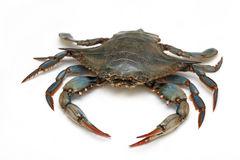Greek crab 220+

SPECIES DESCRIPTION
Crabs are prepared and eaten as a dish in several different ways all over the world. Some species are eaten whole, including the shell, such as soft-shell crab; with other species, just the claws and/or legs are eaten. The latter is particularly common for larger crabs, such as the snow crab. Mostly in East Asian cultures, the roe of the female crab is also eaten, which usually appears orange or yellow in fertile crabs.
In some regions, spices improve the culinary experience. In Southeast Asia and Indosphere, masala crab and chilli crab are examples of heavily spiced dishes. In the Chesapeake Bay region, blue crab is often eaten with Old Bay Seasoning. Alaskan king crab or snow crab legs are usually simply boiled and served with garlic or lemon butter.
For the British dish Cromer crab, the crab meat is extracted and placed inside the hard shell. One American way to prepare crab meat is by extracting it and adding a flour mix, creating a crab cake. Crabs are also used in bisque, a global dish of French origin.
Imitation crab, made from minced fish products that are crafted to resemble crab meat, is disdained throughout the culinary industry as an unacceptably low-quality substitute for real crab. This does not hinder its popularity in Japan (where it originated) and in home cooking, where cost is often a chief concern.
